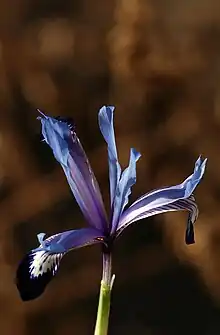| Iris reticulata var. bakeriana | |
|---|---|
 | |
| Scientific classification | |
| Kingdom: | Plantae |
| Clade: | Tracheophytes |
| Clade: | Angiosperms |
| Clade: | Monocots |
| Order: | Asparagales |
| Family: | Iridaceae |
| Genus: | Iris |
| Section: | Iris sect. Reticulatae |
| Species: | |
| Variety: | I. r. var. bakeriana |
| Trinomial name | |
| Iris reticulata var. bakeriana | |
| Synonyms[1] | |
| |
Iris reticulata var. bakeriana is a variety of Iris reticulata, a plant in the genus Iris. It is sometimes treated as Iris bakeriana,[2] especially in the USA.
Description
The bulbs are more pointed and slender in shape than other reticulata irises in the genus.[3] It grows to about 10 cm tall, with a 5–6 cm tall flower. It has bluish lilac standards and styles. Falls are white with deep blue tips, lines, and blotches.[4] It also has pale blue veining.[5] This variety of iris has nearly cylindrical leaves unlike other reticulata species.[4] It blooms in early spring, normally February.[2]
Biochemistry
As most irises are diploid, having two sets of chromosomes, this can be used to identify hybrids and classification of groupings.[6]: 18 It has a chromosome count: 2n=20, counted by Johnson & Brandham in 1997.[7][5]
Taxonomy
The Latin specific epithet reticulata refers to the Latin word for net, and bakeriana is in honor of the English botanist John Gilbert Baker.[8]
It was originally found in Armenia near the city of Mardin(in Turkey).[9]
It was originally described and published by Sir Michael Foster as Iris bakeriana in Curtis's Botanical Magazine, Tab. 7084. on November 1, 1889.[10]
Then in Flora Iranica (1975) it was re-classified to be a variety of Iris reticulata by Wendelbo.[11] This now is accepted by most botanists. Iris bakeriana (Foster) then become a synonym for the plant.[1] Although the United States Department of Agriculture and the Agricultural Research Service still class Iris bakeriana as a true species.[12]
Iris reticulata var. bakeriana is an accepted name by the RHS.[13]
Distribution and habitat
Iris reticulata var. bakeriana is native to the temperate areas of Asia,[12] mainly Iran, Iraq and Turkey.[12][5] It is found on rocky hillsides,[4] with heavy clay soil.[5]
Cultivation
It is suitable for a rock or gravel garden or front of border. It is hardy between USDA Zones 3–9.[5]
Cultivars
Cultivars regarded as involving I. reticulata var. bakeriana include:
References
- 1 2 "Iris reticulata var. bakeriana (Foster) B.Mathew & Wendelbo". theplantlist.org. Retrieved 31 October 2014.
- 1 2 3 Wyman, Donald. Wyman's Gardening Encyclopedia, p. 575, at Google Books
- ↑ "Reticulata Or Dwarf Bulbous Irises". www.herbs2000.com. Retrieved 16 July 2014.
- 1 2 3 "Reticulata Irises". www.pacificbulbsociety.org. 11 May 2014. Retrieved 14 July 2014.
- 1 2 3 4 5 Zera, Sean (6 April 2009). "Iris bakeriana". www.signa.org. The Species Iris Group of North America. Retrieved 9 June 2020.
- ↑ Austin, Claire (2005). Irises; A Garden Encyclopedia. Timber Press. ISBN 0881927309.
- ↑ Pries, Bob (4 December 2016). "SpecBakeriana < Spec < Iris Wiki". wiki.irises.org. The American Iris Society. Retrieved 9 June 2020.
- ↑ Dr Ross Bayton RHS Gardener’s Botanical: An Encyclopedia of Latin Plant Names (2019), p. 55, at Google Books
- ↑ Lynch, RichardThe Book of the Iris, p. 163, at Google Books
- ↑ "Scientist Sir Michael Foster (1836 - 1907)". wiki.irises.org (American Iris Society). 2 July 2014. Retrieved 14 July 2014.
- ↑ Walters, Stuart Max (Editor)European Garden Flora: A Manual for the Identification of Plants Cultivated, p. 354, at Google Books
- 1 2 3 "Iris reticulata var. bakeriana". Germplasm Resources Information Network. Agricultural Research Service, United States Department of Agriculture. Retrieved 9 June 2020.
- ↑ "Iris reticulata var. bakeriana". www.rhs.org.uk. Retrieved 31 October 2014.
- 1 2 Stebbings, Geoff (1997). The Gardener's Guide to Growing Irises. Newton Abbot: David and Charles. p. 73. ISBN 0715305395.
- ↑ Mathew, Brian (1 May 2007). "Irises: An expert reveals the secrets of growing the jewel-like reticulatas". www.hortmag.com. Retrieved 16 July 2014.
- ↑ "(Spx) 'Melaina'". wiki.irises.org (American Iris Society). Retrieved 16 July 2014.
Other sources
- Mathew, B. 1981. The Iris. 173
External links
 Data related to Iris reticulata var. bakeriana at Wikispecies
Data related to Iris reticulata var. bakeriana at Wikispecies